#Fishing Conservation
Text
#Fishing Tips#Bass Fishing#Fly Fishing#Deep Sea Fishing#Saltwater Fishing#Freshwater Fishing#Fishing Gear Reviews#Fishing Techniques#Fishing Locations#Fishing Tournaments#Ice Fishing#Carp Fishing#Trout Fishing#Fishing Rods#Fishing Reels#Fishing Bait#Fishing Tackle#Fishing Licenses#Catch and Release#Fishing Conservation#Fishing Knots#Fishing Boats#Fishing Guides
2 notes
·
View notes
Text
If you aren't following the news here in the Pacific Northwest, this is a very, very big deal. Our native salmon numbers have been plummeting over the past century and change. First it was due to overfishing by commercial canneries, then the dams went in and slowed the rivers down and blocked the salmons' migratory paths. More recently climate change is warming the water even more than the slower river flows have, and salmon can easily die of overheating in temperatures we would consider comfortable.
Removing the dams will allow the Klamath River and its tributaries to return to their natural states, making them more hospitable to salmon and other native wildlife (the reservoirs created by the dams were full of non-native fish stocked there over the years.) Not only will this help the salmon thrive, but it makes the entire ecosystem in the region more resilient. The nutrients that salmon bring back from their years in the ocean, stored within their flesh and bones, works its way through the surrounding forest and can be traced in plants several miles from the river.
This is also a victory for the Yurok, Karuk, and other indigenous people who have relied on the Klamath for many generations. The salmon aren't just a crucial source of food, but also deeply ingrained in indigenous cultures. It's a small step toward righting one of the many wrongs that indigenous people in the Americas have suffered for centuries.
#salmon#dam removal#fish#animals#wildlife#dams#Klamath River#Klamath dams#restoration ecology#indigenous rights#Yurok Tribe#Karuk Tribe#nature#ecology#environment#conservation#PNW#Pacific Northwest
13K notes
·
View notes
Text
Hey. You.
Check out this weird fish.

Cool, huh? It's got no bones and it's older than T rex. Wanna learn more? Check out Consider Nature:
#animals#science#biology#nature#conservation#wildlife#environment#fish#fishing#ecology#considernature
5K notes
·
View notes
Text
The Klamath River’s salmon population has declined due to myriad factors, but the biggest culprit is believed to be a series of dams built along the river from 1918 to 1962, cutting off fish migration routes.
Now, after decades of Indigenous advocacy, four of the structures are being demolished as part of the largest dam removal project in United States history. In November, crews finished removing the first of the four dams as part of a push to restore 644 kilometres (400 miles) of fish habitat.
“Dam removal is the largest single step that we can take to restore the Klamath River ecosystem,” [Barry McCovey, a member of the Yurok Tribe and director of tribal fisheries,] told Al Jazeera. “We’re going to see benefits to the ecosystem and then, in turn, to the fishery for decades and decades to come.” ...
A ‘watershed moment’
Four years later, [after a catastrophic fish die-off in 2002,] in 2006, the licence for the hydroelectric dams expired. That created an opportunity, according to Mark Bransom, CEO of the Klamath River Renewal Corporation (KRRC), a nonprofit founded to oversee the dam removals.
Standards for protecting fisheries had increased since the initial license was issued, and the utility company responsible for the dams faced a choice. It could either upgrade the dams at an economic loss or enter into a settlement agreement that would allow it to operate the dams until they could be demolished.
“A big driver was the economics — knowing that they would have to modify these facilities to bring them up to modern environmental standards,” Bransom explained. “And the economics just didn’t pencil out.”
The utility company chose the settlement. In 2016, the KRRC was created to work with the state governments of California and Oregon to demolish the dams.
Final approval for the deal came in 2022, in what Bransom remembers as a “watershed moment”.
Regulators at the Federal Energy Regulatory Commission (FERC) voted unanimously to tear down the dams, citing the benefit to the environment as well as to Indigenous tribes...
Tears of joy
Destruction of the first dam — the smallest, known as Copco 2 — began in June, with heavy machinery like excavators tearing down its concrete walls.
[Amy Cordalis, a Yurok Tribe member, fisherwoman and lawyer for the tribe,] was present for the start of the destruction. Bransom had invited her and fellow KRRC board members to visit the bend in the Klamath River where Copco 2 was being removed. She remembers taking his hand as they walked along a gravel ridge towards the water, a vein of blue nestled amid rolling hills.
“And then, there it was,” Cordalis said. “Or there it wasn’t. The dam was gone.”
For the first time in a century, water flowed freely through that area of the river. Cordalis felt like she was seeing her homelands restored.
Tears of joy began to roll down her cheeks. “I just cried so hard because it was so beautiful.”
The experience was also “profound” for Bransom. “It really was literally a jolt of energy that flowed through us,” he said, calling the visit “perhaps one of the most touching, most moving moments in my entire life”.
Demolition on Copco 2 was completed in November, with work starting on the other three dams. The entire project is scheduled to wrap in late 2024.
[A resilient river]
But experts like McCovey say major hurdles remain to restoring the river’s historic salmon population.
Climate change is warming the water. Wildfires and flash floods are contaminating the river with debris. And tiny particles from rubber vehicle tires are washing off roadways and into waterways, where their chemicals can kill fish within hours.
McCovey, however, is optimistic that the dam demolitions will help the river become more resilient.
“Dam removal is one of the best things we can do to help the Klamath basin be ready to handle climate change,” McCovey explained. He added that the river’s uninterrupted flow will also help flush out sediment and improve water quality.
The removal project is not the solution to all the river’s woes, but McCovey believes it’s a start — a step towards rebuilding the reciprocal relationship between the waterway and the Indigenous people who rely on it.
“We do a little bit of work, and then we start to see more salmon, and then maybe we get to eat more salmon, and that starts to help our people heal a little bit,” McCovey said. “And once we start healing, then we’re in a place where we can start to help the ecosystem a little bit more.”"
-via Al Jazeera, December 4, 2023
#indigenous#river#riverine#ecosystem#ecosystem restoration#klamath#klamath river#oregon#california#yurok#fishing#fisheries#nature is healing#literally this time lol#united states#dam removal#climate change#conservation#sustainability#salmon#salmon run#water quality#good news#hope#rewilding#ecology#environment
5K notes
·
View notes
Text
Animal of the Day!
Flying Gurnard (Dactylopterus volitans)

(Photo from Shorefishes)
Conservation Status- Least Concern
Habitat- Atlantic Ocean
Size (Weight/Length)- 50 cm
Diet- Crustaceans; Small fish; Aquatic worms
Cool Facts- The flying gurnard is a magnificent fish with its gorgeous ‘wings’. These ‘wings’ are just extremely long pectoral fins. They are displayed when the fish grows excited or nervous and allows its body to look much larger, and harder to swallow, than it did a few seconds ago. They tend to stick to the sandy bottom of the shallow ocean, walking on the floor using their pelvic fins. Flying gurnards can only swim for short bursts using their ‘wings’ like a gliding mechanism through the water. These fish are capable of making a low, grunting noise by vibrating their swim bladder. Scientists believe they may use these noises to communicate with each other or possibly frighten predators.
Rating- 12/10 (Their wing-tips are edged in phosphorescent blue.)
#animal of the day#animals#fish#marine creatures#wednesday#november 15#flying gurnard#biology#science#conservation#the more you know
1K notes
·
View notes
Text

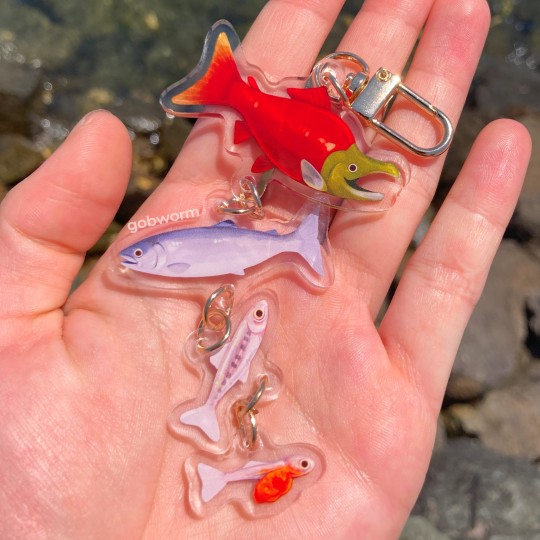
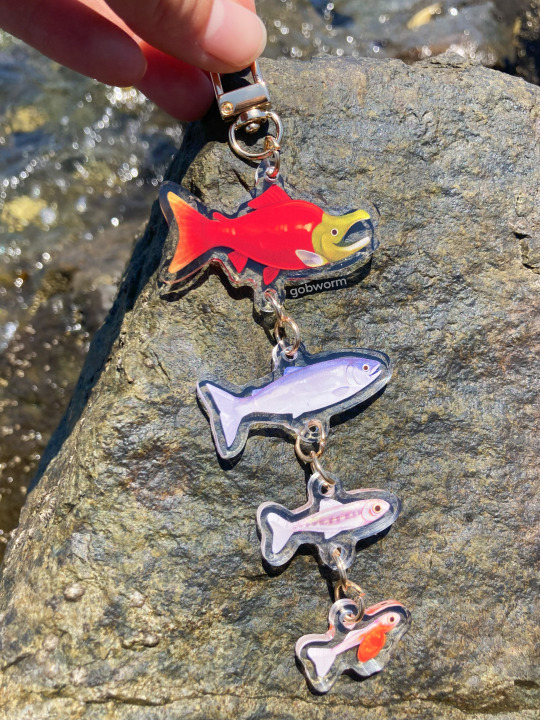
salmon life cycle charms!
buy them here!
#salmon#fish#fish biology#ichthyology#fishblr#sea creatures#marine life#marine biology#life cycle#biology#zoology#ecology#conservation#acrylic charms#small business#acrylic keychain#etsy shop#shop small#art business#digital art#artists on tumblr
3K notes
·
View notes
Text

juvenile and adult zebra shark
// Full illustration for Swim On 9: Mangroves @swimonzine
#sharks#zebra shark#gentlesharks#nature#ocean#conservation#underwater#fish#swimonzine#digital#drawing#illustration#full illustration#art#feral#zine#marine life
1K notes
·
View notes
Text

Pacific Lamprey Conservation
After hiding under the substrate at a fish research center for nearly 7 years as larvae, Pacific lamprey EMERGED as juveniles with eyes and a suction disk mouth!
These fish, which are of Tribal and ecological importance, are now ready for their journey out to sea!
The Abernathy Fish Technology Center in Washington worked in collaboration with the Yakama Nation, the Confederated Tribes of the Umatilla Indian Reservation and the Chelan County Public Utility District to conduct this research to further understand and conserve Pacific lamprey.
This is a rare accomplishment to have Pacific lamprey reared and transformed in a captive setting.
USFWS photo: Amanda Sheehy
via: USFWS Columbia Pacific Northwest
#lamprey#ichthyology#fish#agnatha#nature#conservation#ocean#rivers#aquatic#PNW#north america#science#environment
642 notes
·
View notes
Text
Kentucky tennessee and alabama have the most diverse freshwater animals in the entire world
Some of them are so pretty! Just look at these fishes

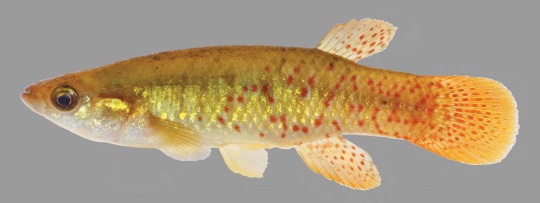

Speckled Darter, Golden Topminnow, Emerald Darter
3K notes
·
View notes
Text
HEY TUMBLR, I KNOW PROBABLY NOONE WILL SEE THIS BUT IF YOU ARE ABLE, CAN YALL DONATE TO HELP THIS FISH!
THANK YOU
382 notes
·
View notes
Text
—
“the U.S. Supreme Court rejected the State of Alaska’s bid to fast-track the legal process, overrule the Environmental Protection Agency (EPA), and gain approval for the Pebble Mine — slated to extract enormous amounts of copper, gold, and molybdenum from the pristine and sensitive ecosystem known as Bristol Bay.
A diverse coalition led by Alaska Natives has consistently fought against the proposed mine for more than two decades. It eventually gained support from the EPA, which ultimately blocked the mine proposal in January 2023 over concerns it would threaten an aquatic ecosystem supporting the world’s most prolific sockeye salmon fishery.
This decision is significant, particularly considering the current High Court’s tendency to support states’ rights, limits on regulation — especially of the environmental variety — and corporate concerns. Alaska’s request, filed in June, was unusual in that it sought to skip lower appeals courts to challenge the EPA’s decision on the basis that it violated Alaska’s state sovereignty.
Under the law, alleged violations of state sovereignty are one of the few categories of cases that grant the Supreme Court original jurisdiction — meaning a state can bypass the usual state/federal court appeals process and file straight with the High Court. The justices could easily have decided to hear the case and decide in favor of the mining company, which has shown no qualms about engaging in some shady business practices over the years.
As the single most productive sockeye salmon fishery in the world, Bristol Bay contains biodiversity and abundant wild fish populations which present a stark contrast to many other fisheries in the Pacific Northwest (and worldwide). Most have experienced severe depletion over the last few decades. Sockeye salmon — like all Pacific Salmon — are a keystone species, vital to the health of an entire ecosystem. Of course, salmon also provide a sacred food source for Indigenous communities up and down the West Coast.”
-from the Lakota People’s Law Project
#good news#environmentalism#nature#environment#environmental law#environmental justice#indigenous activism#conservation#fish#salmon#usa#alaska#alaska natives
378 notes
·
View notes
Text
#Fishing Tips#Bass Fishing#Fly Fishing#Deep Sea Fishing#Saltwater Fishing#Freshwater Fishing#Fishing Gear Reviews#Fishing Techniques#Fishing Locations#Fishing Tournaments#Ice Fishing#Carp Fishing#Trout Fishing#Fishing Rods#Fishing Reels#Fishing Bait#Fishing Tackle#Fishing Licenses#Catch and Release#Fishing Conservation#Fishing Knots#Fishing Boats#Fishing Guides
0 notes
Text
This is from last summer (I found it while trying to clean up browser tabs--oops.) Anyway, it's one of many examples of critically endangered species showing an upturn in population with support. The Devils Hole pupfish is particularly imperiled because it is only found in one flooded cavern in Nevada's Amargosa Desert; the species is likely descended from fish that were washed in there by flooding thousands of years ago, and have managed to eke out a living in the hot, oxygen-deficient water ever since.
This is one of the first species ever listed under the U.S. Endangered Species Act. Devils Hole is threatened by groundwater depletion from well drilling, and after the pupfish's ESA listing there were numerous legal battles between conservationists and farmers over water usage. Water levels reached their lowest point in the early 1970s, but have been slowly rising since then.
Scientists are excited because the current wild population (at least as of last fall) is at 263 fish. That's up from just 35 in 2013, the lowest recorded population ever. There are a few hundred more in captivity, being used to breed more young for reintroduction. The hope is that this fall's wild count will break 300, a good sign for the world's most endangered fish.
By the way, THIS is the entirety of the Devils hole pupfish's habitat, the only place in the world where they are found:
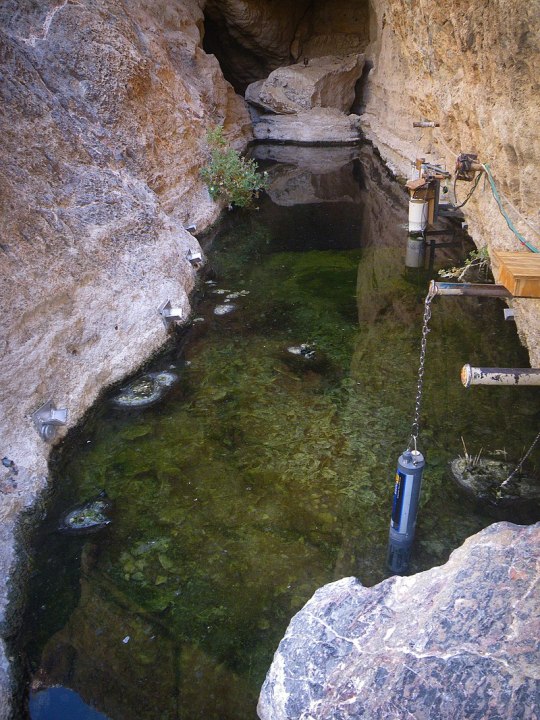
#Devils Hole pupfish#Devils Hole#fish#icthyology#vertebrates#animals#wildlife#endangered species#endangered animals#extinction#nature#ecology#environment#conservation#science#scicomm#Nevada#United States#Endangered Species Act#Endangered Species List
1K notes
·
View notes
Text
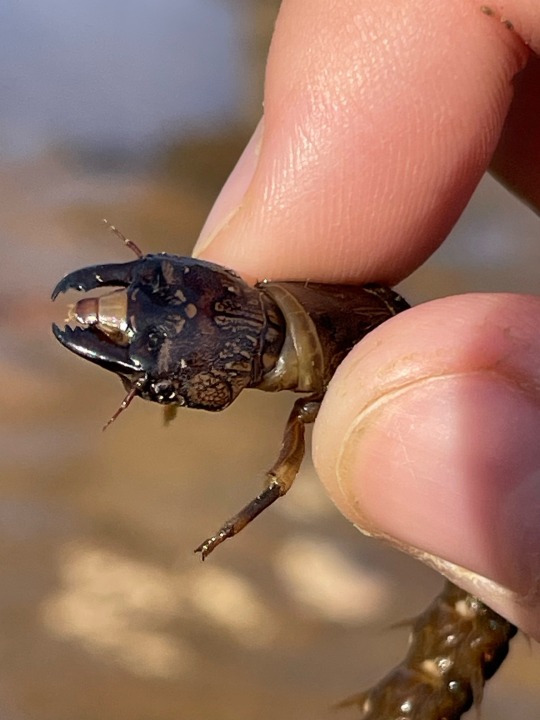
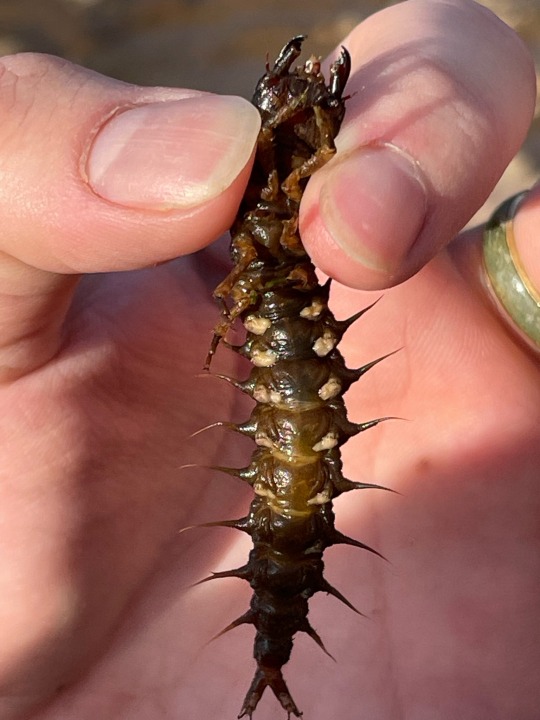

hellgrammite!!! (eastern dobsonfly nymph)
I love these so much, their patterns are so beautiful. They can bite pretty hard, but i’ve never had one bite me at all. otherwise they’re harmless!
you can see its abdominal gills as well, which are really fucking cool !!
#hellgrammite#fishing#fishblr#conservation#nature#biology#insects#bugs#entomology#macroinvertebrates#bugcore#wildlife#wildlife photography#bug photography
227 notes
·
View notes
Link
“Famous more as a cultural feature than as a natural one, the pace at which the River Mersey is recovering to a fishy wonderland has ecologists stunned.
Splitting The Beatles’ home city of Liverpool in two, a recent survey found 37 different species of fish, more than two-and-a-half-times as many as were found in the previous survey 20 years ago.
Five different species of sharks were also found, along with huge eels and sea scorpions. ‘Holiday species’ as one local fishermen called them, like turbot, smelt, and cod, have also been caught.
Scientists at the Mersey Rivers Trust, a public/private charity-driven partnership for nature in the area believe that these species are breeding in the 3 mile-wide estuary.
The Liverpool Docks—the largest enclosed dock system in the world, were described by Herman Melville as comparable to the Pyramids in size and construction. As a result, industrialization heavily polluted the river. In 2009 however it was announced that the river was “cleaner than at any time since the industrial revolution” and is “now considered one of the cleanest [rivers] in the UK.”
“Over the last 30 years, there’s been this tremendous regeneration, this renewal of the River Mersey that started slowly but is now picking up pace. I still think we’re right at the beginning of something special,” said Mike Duddy at the Mersey Rivers Trust, who spoke to the Wirral Globe about the restoration...
Humpback whales were recently seen in Liverpool Bay for the first time since 1938, while the Mersey itself has also welcomed back otters, salmon, octopus, porpoises, and seals.
The Trust is currently compiling a species list, and is holding a competition with local fishermen to see how many can be recorded. Duddy expects to raise the count of 37 fish species to 50 next year.”
-via Good News Network, 1/23/23
#england#uk#liverpool#conservation#water pollution#biodiversity#ecosystem restoration#fish#sharks#eels#humpback whale#otter#salmon#octopus#porpoise#seal#rivers#good news#hope
3K notes
·
View notes
Text
Animal of the Day!
Deepsea Lizardfish (Bathysaurus ferox)

(Photo from Ocean Conservancy)
Conservation Status- Least Concern
Habitat- Indo-Pacific Ocean; Atlantic Ocean
Size (Weight/Length)- 60 cm
Diet- Fish; Crustaceans; Other deepsea lizardfish
Cool Facts- The deepsea lizardfish lives up to 3,500 meters below the surface. This makes them one of the deepest, living, apex predators. Their bodies are relatively flat, allowing them to lay flush against the ocean floor. When an unknowing fish swims past, the deepsea lizardfish uses its enormous, tooth-lined mouth to snare prey. Their massive pupils help the lizardfish to see the smallest flashes of bioluminescent light to spot food. Like the majority of ocean life, deepsea lizardfish are threatened by overfishing of their prey and rapid ocean acidification.
Rating- 13/10 (Yes, this is from Earth and not 4546B.)
#animal of the day#animals#fish#marine creature#lizardfish#saturday#september 2#deepsea lizardfish#biology#science#conservation#the more you know
601 notes
·
View notes